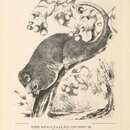en
names in breadcrumbs


'Peregrinus', means "foreign false hand" in Latin (Sydney Metropolitan Wildlife Services Inc. 2000).
Perception Channels: tactile ; chemical
During the 1950's common ringtail possum populations severely declined in numbers. Currently populations seem to have recovered.
Deforestation in Australia has resulted in a loss of habitat for common ringtail possums, because they are almost exclusively arboreal. In suburban areas they are vulnerable to being struck by cars, or hunted by cats and dogs (Sydney Metropolitan Wildlife Services Inc. 2000).
US Federal List: no special status
CITES: no special status
IUCN Red List of Threatened Species: least concern
Common ringtail possums do not adversely affect humans. Unlike brushtail possums, they are not considered pests in suburban areas and do not nest within homes or human structures (Sydney Metropolitan Wildlife Services Inc. 2000).
None known.
Common ringtail possums are nocturnal and primarily folivorous. They feed mainly on eucalyptus leaves, but may also eat flowers, buds, nectar, and fruit. Part of the common ringtail possum's caecum is able to detoxify the tannins and phenols that are present in eucalyptus leaves, making them capable of taking advantage of this food source. A low metabolic rate helps to compensate for the low energy intake of common ringtail possums due to their specialized diet. Feeding occurs both during the first half of the night and, again, before dawn. Common ringtail possums prefer eating the youngest foliage of the plants they consume. This effects reproductive patterns, as the young leave the pouch and are weaned during times when flower and fruit growth peaks (Barnett et al. 1984).
When they are found in urban Australian areas, common ringtail possums eat rose buds (Sydney Metropolitan Wildlife Service Inc. 2000).
Common ringtail possums are found along the eastern coastline of Australia, Tasmania, and the southwestern corner of western Australia (Marsupial Society of Victoria Inc. 2000).
Biogeographic Regions: australian (Native )
Common ringtail possums have an extensive distribution. They occur in temperate or tropical areas but are rarely found in drier areas. It is thought that this wide habitat range is due to their ability to feed on a number of different plant species. They can usually be found in dense brush forests, as they favor environments that are plentiful with eucalyptus. The dense brush is also optimal for the construction of dreys. Along with several other species, the common ringtail possum occupies a range of niches comparable to the niche's of lemurs, monkeys, squirrels, and bushbabies in similar forests on other continents (Barnett et al. 1984; Lee and Smith 1984).
Terrestrial Biomes: forest
Average lifespan
Status: wild: 5.0 years.
Average lifespan
Status: captivity: 8.0 years.
Average lifespan
Status: wild: 6.0 years.
Common ringtail possums are the smallest of eight species of ringtail possums that live in Australia. The adults of this species typically are between 30 and 35 cm in body length, with a tail length that is roughly equal to the body length. Common ringtail possums have brown or reddish fur on the upper surfaces of the body and light colored or gray fur on the ventral surfaces. Common ringtail possums have large eyes which are well adapted to seeing at night. Two of the claws found on the front feet are opposable and the pads, as well as the tips, of the toes are grooved. They possess a strong, but relatively hairless, prehensile tail. This tail is carried tightly curled when not in use. These animals can be distinguished from other possum species in several ways. Their ears are smaller and more rounded and they typically have patches of white fur both on and above the ears. The tail of common ringtail possums has a white tip and is tapered (Marsupial Society of Victoria Inc. 2000; Wildlife Welfare Org. of S.A. 2000).
Range mass: 500 to 1000 g.
Average mass: 700 g.
Other Physical Features: endothermic ; bilateral symmetry
Average basal metabolic rate: 2.27 W.
Common ringtail possums are marsupials, thus they carry their young in a pouch while they develop. Mating takes place between April and December, depending on the location in Australia. Most young are born sometime between May and July. Both males and females are sexually mature in the mating season after their birth. Common ringtail possums are polyestrous as well as polyovular. The estrous cycle of this species lasts for 28 days (Barnett et al. 1984).
Most common ringtail possums have litters of two offspring, however they can have up to four. It has been suggested that six embryos are born at the same time, however, only two of those six are able to find a useable nipple, thus the other four usually die. The female's pouch has a forward facing opening; two of the four nipples are functional at one time. Older females can produce up to two litters of young per year (Wildlife Welfare Org of S.A. 2000).
Initial growth of the common ringtail possum young is generally slow. This slow growth occurs during the period when female weight is lowest. Between 90 and 106 days after birth, the young both open their eyes and are able to make clear vocalizations. Between 120 and 130 days after birth the young emerge from their mother's pouch. However, lactation generally does not stop until between 180 and 220 days after birth, sometimes ending as early as 145 days (Barnett et al. 1984; Gilmore and Stonehouse 1997).
Key Reproductive Features: gonochoric/gonochoristic/dioecious (sexes separate); sexual
Average birth mass: 0.3 g.
Average number of offspring: 2.
Average age at sexual or reproductive maturity (male)
Sex: male: 365 days.
Average age at sexual or reproductive maturity (female)
Sex: female: 365 days.